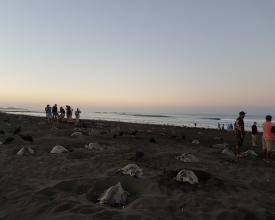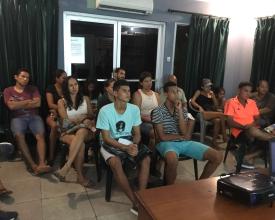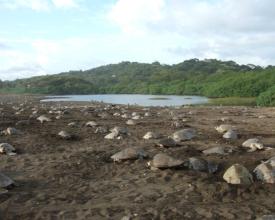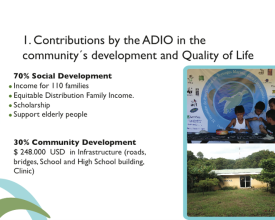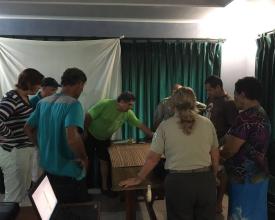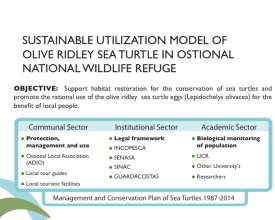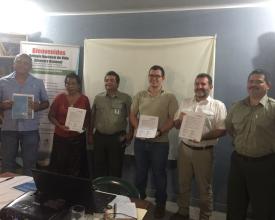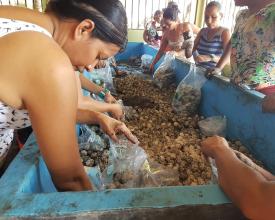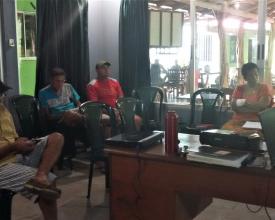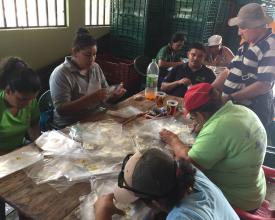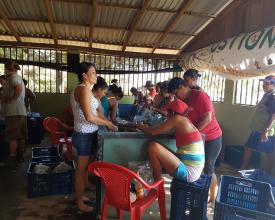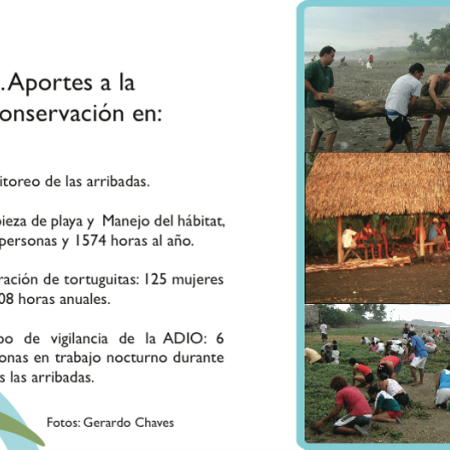
The positive relationaship between the Ostional community and the conservation of olive ridley sea turtles.
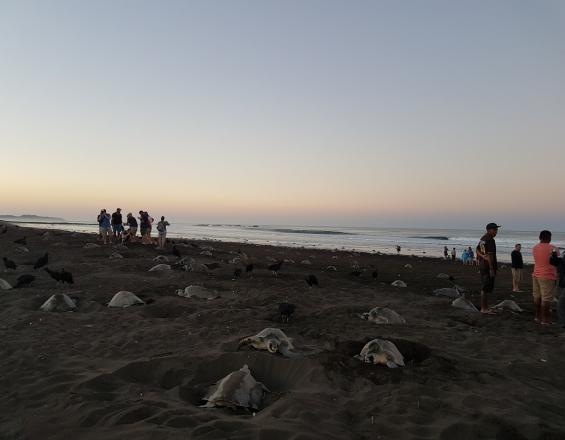
Ostional beach is a second largest beach nesting site of Olive ridley (Lepidochelys olivacea) in the world. With the simultaneous arrival of hundreds of turtles to the beach of Ostional, high mortality of eggs was observed due to over-excavation, illegal poaching of eggs and natural causes. This promoted the creation of the Refuge and the design of a project where the community implement actions of habitat protection and a regulated use of turtle eggs is permitted, and contribuid with the development of the residents of Ostional.
Contexto
Défis à relever
Through annual planning between the institutions of government and the community, economic and operational resources of both parties are optimized, which has improved the conservation of turtles and their nests.
Habitat management, limiting the use of eggs in time and space and the absolute protection of nests outside the crop area can improve the survival conditions of most nests each arribada.
It also includes a regulatory framework for harvesting eggs, for packaging, handling and transport of eggs, control and surveillance on the beach and outside. Rules for the marketing and distribution of eggs, for visitation of tourists to volunteer work and habitat management.
The community of Ostional is organized periodically for protection against predation of neonates during the day as well as in births during times of extreme heat, which are carried cold spots from the beach to reach the sea and survive .(Five-Year Plan 2012-2016).
Ubicación
Procesar
Resumen del proceso
The planning committee and management composed of ADIO, INCOPESCA, SINAC and the University of Costa Rica are jointly involved in action planning and project evalution. Some activities are performed jointly, others are performed separately, but always in pursuit of implementing the management plan. All contributions of the sectors are important in learning and empowerment. Representatives of ADIO give a fundamental contribution in volunteer hours. The contribution of the research is critical to ensure that the actions taken, but especially the use of the resource, are not hurting the nesting population. The contribution of INCOPESCA and SINAC is essential to ensure legality of the project, decreasing illegal extraction and sales of eggs.
The population of Playa Ostional grouped in about 110 families, benefit directly 92%, and through the communal works developed by ADIO, benefit 100% of the people in the community. These people also participate in organized work accounting for the hours invested in the management actions of the beach and the care of the turtles.
Bloques de construcción
Commission for the management and protection of sea turtles.
1.By consensus of the interested parties, INCOPESCA, ADIO, UCR, and SINAC created a commission of co-management and created a legal framework established with executive decree DAJ-020-2005, in order to work together and this group of Co-management launches a management plan for the conservation and sustainable use of turtles (Lepidochelys olivacea) nesting on Ostional beach.
Representatives of the ADIO, UCR, INCOPESCA and SINAC developed jointly and by consensus four products that were the basis for the development of the new five-year management proposal:
· a basic characterization of the roles of the actors and the main elements of their experience, which identified the keys to a successful plan for future use
· an interpretation framework as reference to outline the guidelines of the use plan for the next five years
· the principles governing the plan
· general and specific rules and objectives
Factores facilitadores
The SINAC and INCOPESCA authorization and supervision of the Ostional Development Association (ADIO) to use eggs as a means of subsistence (consumption and sale). The community benefits from consumption of the egg as food and also to receive the economic resources that are distributed between people and social welfare, while contributing to the conservation of the turtle, through the cleaning of the beach and the care Of turtle hatchlings.
Lección aprendida
One of the most important lessons derived was the fact that it was evident that all this process was effectively a management and conservation model, whose most important strategic results are about maintaining and conserving a habitat that maintains the massive arrivals, the birth and arrival to the sea of more than one million tortuguitas annually, which translates into a significant contribution for the conservation of the turtle population.
The characterization of the actors' roles and the main elements of their historical experience, which allowed us to validate the keys to a successful exploitation plan, with a framework of agreements, norms and rules and decisions shared between the actors indicating the contributions and investments, As well as the obligations during its execution and the usufruct of the benefits, signed and recognized by all the parties involved.
Distribution of profit to families
The ADIO represents 110 families of the Ostional community. They are the main partners responsible for implementing the actions of habitat maintenance, collecting eggs according to plan management and conservation and packaging of eggs. Of the ADIO sales, 70% are distributed to members and 30% are reserved for local development such as construction of roads, bridges, health centers and school resources. The direct benefit that each family receives are: an endowment of eggs for consumption, an equitable distribution of family income, scholarships for students, aid to elderly and pregnant adults.
Factores facilitadores
Ostional Development Association is a legal institution for engaging communities for collective benefit of the community. In this case the management and conservation of turtles is a model project developed by the community and for the community. The ADIO has partners and participates in assemblies of the people. It also has a Board of Directors who bears the burden of the project. They also form committees to monitor the actions of the management plan.
Lección aprendida
The participation of all people in the project is critical to creating the collective consciousness about sustainability. Jobs are evenly distributed: beach cleaning and habitat management mainly engage men; protection of turtle infants and release of turtles, mainly women. Surveillance by ADIO is done mostly by men; and supervision of tourists who observe the arrival, by youth. In this way, the contribution of the project to local community welfare and conservation is evident. When communities see a benefit for their families in the wildlife, they are able to organize themselves in order to protect those resources that provide that well-being.
Impactos
Part of the harvested eggs are dedicated to feeding the residents of the nearby beach Ostional, giving communities a certain amount per family and the rest is sold in the domestic market by the partners of the ADIO. The income from these resources are distributed 70% to the social development of the community and 30% for the development of community services.
Part of the scope of the project were the stability of the population of turtles in arribada and covering each month of the year. The production of millions of offspring annually without nursery is one of the highlights. Protection increases survival to 10% with respect to the days when there is no protection. Maintenance of habitat for nesting has managed to ensure their quality and increase nesting area of several thousand square meters.
The tourist use is just beginning but is seen as a great opportunity for the community in the possibilities of providing accommodation services, food and as guides for observing turtles.
Objetivos de Desarrollo Sostenible
Historia

In Costa Rica in 1970, aerial surveys showed that there were two mass nesting beaches for Olive Ridley Sea Turtles, one of them being Playa Ostional Beach. Both are now protected areas and managed by the Ministry of Environment and Energy (MINAE). However only the National Wildlife Refuge Ostional has allowed a project that integrates the main objective of conservation of these species, while still allowing the use of eggs under certain circumstances, times and amounts. This ensures that the community may have a direct benefit of the resource, without losing sight of the main goal which is to preserve the nesting habitat of the sea turtles. Overall the roles of all participants are defined, goals are set and adaptive management of the marine protected area is performed under the existing conditions. This management approach has improved the understanding of the whole context of human-environment relationships. Through annual planning between the institutions of government and the community, economic and operational resources of both parties are optimized, which has improved the conservation of turtles and their eggs. Marine protected areas as Ostional can provide benefits like these, but also fishing or turtle watching activities without compromising the conservation objectives for the coastal marine ecosystems. Therein lies the success of conservation in Ostional.
